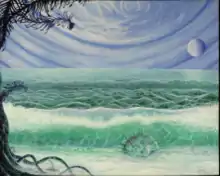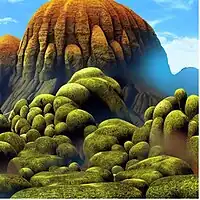Pastoral science fiction
Pastoral science fiction is a subgenre of science fiction which uses bucolic, rural settings, like other forms of pastoral literature. Since it is a subgenre of science fiction, authors may set stories either on Earth or another habitable planet or moon, sometimes including a terraformed planet or moon. Unlike most genres of science fiction, pastoral science fiction works downplay the role of futuristic technologies. The pioneer is author Clifford Simak (1904–1988), a science fiction Grand Master whose output included stories written in the 1950s and 1960s about rural people who have contact with extraterrestrial beings who hide their alien identity.[1]

Pastoral science fiction stories typically show a reverence for the land, its life-giving food harvests, the cycle of the seasons, and the role of the community. While fertile agrarian environments on Earth or Earth-like planets are common settings, some works may be set in ocean or desert planets or habitable moons. The rural dwellers, such as farmers and small-townspeople, are depicted sympathetically, albeit with the tendency to portray them as conservative and suspicious of change. The simple, peaceful rural life is often contrasted with the negative aspects of noisy, dirty, fast-paced cities. Some works take a Luddite tone, criticizing mechanization and industrialization and showing the ills of urbanization and over-reliance on advanced technologies.
Theory

Leo Marx's book The Machine in the Garden: Technology and the Pastoral Idea (1964) sets out the theoretical underpinnings of modern pastoral literature. He states that the pastoral setting has a "dynamic relationship with [t]echnology", which transforms the pastoral ideal of an idyllic paradise into "commodified nostalgia" about a "middle landscape" where lives can be "lived in harmony, momentarily unburdened by history." This sentimental version of the American pastoral uses rural landscapes and sublimation to create a sense of nostalgia and an "illusion of peace and harmony in a green pasture."
Tom Shippey contrasts between the pastoral genre, which focuses on “rural, nostalgic, [and] conservative” communities and genres focused on societies that use technologies to create new tools and devices. For example, in mainstream science fiction, there is often an emphasis on the role of advanced technologies (spaceships, robots, computers, etc.) and their impact on people and society. Shippey states that these literatures about innovation and technology-oriented "fabril" societies depict these cultures as “overwhelmingly urban, disruptive, future-oriented, eager for novelty,”’ and "centred on the image of the ‘faber'" (from proto-Italian "faβros", "to fashion" or "to fit") which historically referred to a blacksmith, but in a science fiction context, it refers to creators, designers, and builders of new artefacts and devices. These could be new spaceships, laser weapons, Artificial Intelligence or other technology.
Andy Sawyer argues that the pastoral genre in science fiction depends on the "tension between these two modes", in which pastoral science fiction (SF) focuses on "anxiety about the future", whereas urban faber society is enthusiastic about the future. Leo Marx gives an example of the busy, noisy urban life disrupting the peaceful rural life with his recounting of Nathaniel Hawthorne working in the woods in the countryside when the quiet was shattered with the shrieking of a train locomotive whistle, showing "technology’s intrusion into the pastoral landscape."[2]
_-_Pastoral_-_N04471_-_National_Gallery.jpg.webp)
Pastoral stories have a nostalgic and sentimental focus on tradition, in contrast to faber cultures which are obsessed with developing innovations. Darko Suvin states that due to "cognitive estrangement", the pastoral genre is closer to science fiction than it is to fantasy. [3] Pastoral symbols and myths are at the roots of American cultural narratives. Along with apocalyptic and urban strands, pastoral symbols are "mutually interpenetrating elements" in American Protestant culture and part of the values of the Enlightenment. [4] The pastoral opposition between the country and the city may be recreated by comparing Earth to a technologically advanced alien planet.[5]
Sawyer uses William Empson's 1950 argument that the pastoral "compress[es] complex meaning into emblematic ecological images" of "wilderness, garden and farm" that serve as "metaphor, a poetic idea" showing the impact of technology on how we relate to nature. Pastoral stories typically focus on communities and regular people's life events, such as falling in love, marriage, birth, and death, and on processes that are key to sustaining rural communities, such as harvesting food. As well, pastoral stories often use the changing seasons as an organizing framework and as metaphor for natural cycles (e.g., Brian Aldiss' Helliconia Spring). Sawyer argues that some pastoral utopias have a dark side, in that the idyllic setting for the few settlers or colonists was achieved at the expense of the land being turned into a dystopia for the Indigenous inhabitants who were displaced or used as slaves to clear the land.
Antecedents
One of the antecedents of pastoral science fiction works was nineteenth century rural utopian pastorals which depicted an idyllic Arcadia. Most utopian writers placed a strong emphasis on technological progress as a way to a better future; examples range from Edward Bellamy's Looking Backward (1888) to King Gillette's The Human Drift (1894) to Alexander Craig's Ionia (1898) to H. G. Wells's A Modern Utopia (1905). However, a minority of nineteenth century utopian writers reacted with a skepticism toward, or even a rejection of, technological progress, and favored a return to a rural, agrarian simplicity.
These "pastoral utopias"[6] include William Morris's News from Nowhere (1891), about a future common ownership society based on agrarian production in small communities where people take pleasure in nature; the "Altrurian trilogy" by William Dean Howells, including A Traveler from Altruria (1894), about a faraway island of Altruria where all resources are shared and craftspeople work slowly on their work, as there is no capitalist pressure (and well as its sequels), and W.H. Hudson's A Crystal Age, a pastoral utopia where people have no machines and only simple devices; they plow their fields with horses and use axes to chop down trees. News from Nowhere is both from the pastoral genre and it is soft science fiction, since the premise of the story is time travel to a utopian future.
Hidden aliens in a rural area
One challenge with writing pastoral science fiction is that if the advanced, futuristic technologies are too prominent, their presence may undercut the bucolic rural setting. One solution is to set the story in an isolated rural area, and have aliens with advanced technologies (interstellar travel, spaceships, etc.) land in the region, but keep their advanced technologies remain hidden from all or almost all people. Sam Jordison states that Simak "pioneered 'pastoral science-fiction'" with Way Station (1963) and earlier stories by creating scenarios in which aliens land in the isolated woods.[7] In Way Station, a Civil War veteran living in a rural farmhouse strikes a deal with aliens soon after the war. In return for letting the aliens convert his house into a hidden "way station" for aliens traveling between galaxies, the aliens give him immortality, so that he is still alive in the 1960s (and appears like a young man). Two other pastoral examples from Simak with "hidden aliens" include "Neighbor" (June 1954 issue of Astounding Science Fiction), which is about a new immigrant to an isolated rural region who arrives with an automated tractor powered by a mysterious advanced technology and the ability to cure illnesses beyond what current medicine can treat (the townsfolk do not realize he is a human-appearing alien), and "A Death in the House" (October 1959 issue of Galaxy), which is about an old farmer who finds a small crashed UFO and an injured alien in the woods, and keeps the discovery hidden from curious big-city scientists until he can repair the alien's spaceship so it can return to its planet.
Pastoral apocalypse
Another way to have a pastoral setting in a futuristic science fiction story is to have an advanced civilization revert to a simple, rural way of life after the cities are destroyed by some apocalyptic disaster. Leigh Brackett’s The Long Tomorrow has been called the "first example of the American pastoral apocalypse" story.[8] The story is set after a nuclear war, and it depicts a world where Mennonites and Amish farmers teach agricultural skills to fleeing refugees from the ruined cities. The beleaguered United States government passes the Thirtieth Amendment, an anti-city law that limits towns to a thousand people, in an effort to prevent re-urbanization. As is common in pastoral stories, the rural setting is contrasted with a densely populated city area. In this story, the urban area is a secret underground site, Bartorstown, that uses advanced technologies such as nuclear power and a supercomputer. The farm-dwelling Mennonites view Bartorstown's advanced technology as the tools of the devil. [9]
Pastoral apocalypse stories are not limited to settings where fertile agrarian communities re-emerge in the countryside from the ashes of disaster. James Lovegrove states that Cormac McCarthy's bleak post-apocalyptic novel The Road, in which a father and his young son journey on foot across the post-apocalyptic ash-covered United States some years after an undefined extinction event, in an America where all plant life and virtually all animal life has died,[10] is a pastoral apocalypse.[11]
The apocalypse does not have to be nuclear war or an extinction event. In Fredric Brown's "The Waveries" (1945 edition of Astounding Science Fiction), aliens invade the United States and they prevent inhabitants from using electricity, so the people have to revert to a simple, rural lifestyle resembling the Amish culture, using horses, buggies and hand tools.
In the 1980s, pastoral themes were used by women science fiction authors to explore feminist issues, such as in Ursula Le Guin's Always Coming Home (1985). Le Guin's novel depicts a women-centric pastoral culture that rebuilds after an apocalypse. The book's setting is a time so post-apocalyptic that only a few folk tales even refer to it. The only signs of our civilization that have lasted into their time are indestructible artefacts such as styrofoam and a self-maintaining, solar-powered computer network. There has been a great sea level rise which floods coastal areas. The Kesh use writing, electricity, and the solar-powered computer network, but they do nothing on an industrial scale, as they deplore domination of the natural environment. They reject cities (literal “civilization”) and limit settlement to a few-dozen multi-family or large family homes.

Terraforming to create a pastoral idyll

Chris Pak believes that the American Pastoral genre changed when the science fiction concept of "terraforming" became popular in the 1950s. Terraforming stories describe the conversion of alien planets into Earth-like places. These 1950s tales tended to use terraforming stories to retell narratives about American pioneers expanding into the west (repackaged as space pioneers exploring and colonizing uncharted planets). Some stories depict dystopian terraforming situations where the pastoral setting was created using immoral practices, like forcing enslaved aliens to do the terraforming work. As well, stories about terraforming can show how these huge environmental projects can devastate the existing alien environment.[12]
Ray Bradbury's The Martian Chronicles from 1958 is a collection of 1940s-era stories which are about the colonization of Mars and its conversion into a planet habitable by humans. Humans' settle Mars to escape the problems on Earth, including devastation by a nuclear war. The stories depict indigenous Martians as hostile to the human explorers, who bring chicken pox to the planet which kills most of the Martians. Bradbury said he "subconsciously borrowed" elements from John Steinbeck's novel The Grapes of Wrath, which Bradbury read at age nineteen, the year the novel was published.[13]
Robert Heinlein's Farmer in the Sky is the earliest novel about terraforming. In the book's future setting, food is carefully rationed on an overcrowded Earth. Teenager Bill Lermer decides to emigrate to a farming colony on Ganymede, one of Jupiter's moons. The arriving colonists realize that the soil has to be built from scratch before it will support crops.
Arthur C. Clarke’s The Sands of Mars (1976) ) is an ironic take on the pastoral depictions of colonization. Examples of stories about planetary adaptation that leads to dystopian outcomes include Frederik Pohl and C.M. Kornbluth’s The Space Merchants (1974), Walter M. Miller’s Crucifixus Etiam (1973), and Poul Anderson’s The Big Rain (2001).[14]
In the late 1950s, terraforming stories were increasingly focused on humans' efforts to modify planets that already had alien species on them (rather than adding life to a sterile, rocky planet). These stories examined the political and philosophical implications of changing the environment of a planet and the impacts on the native inhabitants.[15] In Robert A Heinlein's Red Planet (1949), teens from a Mars colony meet Martian creatures and realize that the native inhabitants are being oppressed. The teens join the Indigenous inhabitants' rebellion against human colonization.
Ursula Le Guin’s The Word for World is Forest is set on a military logging colony set up on the fictional planet of Athshe by people from Earth. The colonists have enslaved the gentle native Athsheans, and treat them harshly. Eventually, one of the native inhabitants s, whose wife was raped and killed by an Earth military officer, leads a rebellion against the loggers, and ousts them from the planet. However, in the process their peaceful Athshean culture is exposed to war for the first time.
Richard McKenna's "Hunter, Come Home" (March 1963 issue of The Magazine of Fantasy and Science Fiction) is about planet ecologies that safeguard humans. It is set on the fictional planet Mordin, where the human colonists use killing a giant creature, the "Great Russel", as their coming of age ritual. Over the years, young men decimate the Great Russels population through this hunt. To ensure that all young men can keep doing the manhood ritual, which is important to their culture, the government tries to terraform a nearby planet with the plan of breeding Great Russels on it. As a preliminary step, the terraforming team releases poison to kill the native plants, but the plants manage to absorb the poison and the terraforming plans are stymied.
Environmental themes

Christopher Cokinos states that Simak's Time and Again has elements that belie the stereotypes we have of the writer, since the "environmental attitude" expands Aldo Leopold's Land Ethic" while using lyricism that also evokes Leopold's approach. [16] The story is about a lost space traveler who had voyaged to a distant star system who finds his way back to Earth after two decades. The space voyager is no longer human after his decades in space, as he was influenced by an alien species with psychic powers. He finds Earth is a comfortable paradise, except that all is not as it seems. Some of the inhabitants are androids that can reproduce, robots work as slaves, and secret assassins have been sent there from the future to prevent him from writing a book in the future that will have a major impact on society.
Sawyer states that Ursula Le Guin is referred to as pastoral science fiction author due to her setting of her science fiction works in "a-technological" countryside settings, such as in City of Illusions (despite the title, most of the story is set in the forest and plains) and the story The Word for World is Forest, which Ian Watson said shows influence from the pastoral poet Andrew Marvell. [17]
In Here There Be Tygers (1972), Ray Bradbury depicts a setting in which a beautiful utopia on a green pastoral planet makes a spaceship's resource extraction team reminisce about their childhoods.[18]

Not all pastoral SF depicts green, fertile agricultural regions or plains teeming with wildlife. Some works in the subgenre are set in forbidding deserts and desolate wastelands such as Frank Herbert’s Dune (1965) and Ursula K. Le Guin’s The Dispossessed (1999). In these harsh environments, humans can only extract meager resources from the land by developing "supportive social frameworks." As such, these works focus on the political implications of resource scarcity for communities.[19]
Joan Slonczewski's A Door into Ocean is another example of feminist pastoral science fiction. It is set in the future, on the fictional planet of Shora, a moon covered by water. The inhabitants of this planet, known as Sharers, are all female and they use genetic engineering to control the ecology of their planet. They are peaceful beings who share resources and treat everyone equally. When they are being threatened by an outside power in an invasion, they resist nonviolently.
References
- Jordison, Sam. "Clifford D Simak: sci-fi in the countryside: The Wisconsin-born writer's now largely forgotten Way Station pioneered 'pastoral science-fiction' - so what happens when aliens land in the woods?". The Guardian. 3 Mar 2009. https://www.theguardian.com/books/booksblog/2009/mar/03/hugo-award-simak-heinlein
- Pak, Chris. CHAPTER 2: The American Pastoral and the Conquest of Space https://doi.org/10.5949/liverpool/9781781382844.003.0003. July 2016 Pages 56–97
- Sawyer, Andy. "Ursula Le Guin and the Pastoral Mode." Extrapolation (pre-2012); Brownsville Vol. 47, Iss. 3, (Winter 2006): 396-416,348. p. 396
- Yanarella, Ernest J. THE CROSS, THE PLOW AND THE SKYLINE. Contemporary Science Fiction and Fantasy and the Ecological Imagination. Brown Walker Press 2022.
- Pak, Chris. CHAPTER 2: The American Pastoral and the Conquest of Space https://doi.org/10.5949/liverpool/9781781382844.003.0003. July 2016 Pages 56–97
- Jean Pfaelzer, The Utopian Novel in America, 1886–1896: The Politics of Form, Pittsburgh, University of Pittsburgh Press, 1984; pp. 51–77, 168–70.
- Jordison, Sam. "Clifford D Simak: sci-fi in the countryside The Wisconsin-born writer's now largely forgotten Way Station pioneered 'pastoral science-fiction' - so what happens when aliens land in the woods?". The Guardian. 3 Mar 2009. https://www.theguardian.com/books/booksblog/2009/mar/03/hugo-award-simak-heinlein
- Walton, Jo. "Pastoral Apocalypse: Leigh Brackett’s The Long Tomorrow". TOR. 19 October 2017. https://www.tor.com/2017/10/19/pastoral-apocalypse-leigh-bracketts-the-long-tomorrow/
- Walton, Jo. "Pastoral Apocalypse: Leigh Brackett’s The Long Tomorrow". TOR. 19 October 2017. https://www.tor.com/2017/10/19/pastoral-apocalypse-leigh-bracketts-the-long-tomorrow/
- Mavri, Kristjan. "Cormac McCarthy's The Road Revisited: Memory and Language in Post-Apocalyptic Fiction". Politics of Memory. No. 2 - Year 3 06/2013 - LC.2.
- Lovegrove, James. “The World of the End of the World: Apocalyptic and Post-Apocalyptic Science Fiction.” Strange Divisions & Alien Territories: The Sub-Genres of Science Fiction, edited by Keith Brooke, Palgrave Macmillan, 2012, pp. 100.
- Pak, Chris. CHAPTER 2: The American Pastoral and the Conquest of Space https://doi.org/10.5949/liverpool/9781781382844.003.0003. July 2016. Pages 56–97
- Bradbury, Ray (2010). "Writing and Creativity". Listen to the Echoes: The Ray Bradbury Interviews (Interview). Interviewed by Sam Weller. Melville House. ISBN 978-1-61219-230-7.
- Pak, Chris. CHAPTER 2: The American Pastoral and the Conquest of Space https://doi.org/10.5949/liverpool/9781781382844.003.0003. July 2016 Pages 56–97
- Pak, Chris. CHAPTER 2: The American Pastoral and the Conquest of Space https://doi.org/10.5949/liverpool/9781781382844.003.0003. July 2016 Pages 56–97
- Cokinos, Christopher. "The Pastoral Complexities of Clifford Simak: The Land Ethic and Pulp Lyricism in Time and Again'". Extrapolation Volume 55, Number 2 https://doi.org/10.3828/extr.2014.9
- Sawyer, Andy. "Ursula Le Guin and the Pastoral Mode." Extrapolation (pre-2012); Brownsville Vol. 47, Iss. 3, (Winter 2006): 396-416,348. p. 396
- Pak, Chris. CHAPTER 2: The American Pastoral and the Conquest of Space https://doi.org/10.5949/liverpool/9781781382844.003.0003. July 2016 Pages 56–97
- Pak, Chris. CHAPTER 2: The American Pastoral and the Conquest of Space https://doi.org/10.5949/liverpool/9781781382844.003.0003. July 2016 Pages 56–97
Further reading
- Bould, Mark. "The Pastoral Science Fiction and Fantasy of Gwyneth Jones/Ann Halam", Foundation 93 (2005), 97–106.
- Cannavò, Peter F. "American Contradictions and Pastoral Visions: An Appraisal of Leo Marx, The Machine in the Garden." Organization & Environment, 14(1), 74-92. https://doi.org/10.1177/1086026601141004.
- Ewald, Robert J. When the Fires Burn High and the Wind is from the North: The Pastoral Science Fiction of Clifford D. Simak. San Bernadino, CA: Borgo Press, 2006.
- Fisher, Judith L. "Trouble in Paradise: The Twentieth-Century Utopian Ideal". Extrapolation; Wooster, Ohio Vol. 24, Iss. 4, (Winter 1983): 329.
- Stephensen-Payne, Phil. Clifford D. Simak: Pastoral Spacefarer: a Working Bibliography. Issue 39 of Bibliographies for the Avid Reader Series. University of Virginia, 1991. ISBN 1871133289, 9781871133288
See also
- Mundane science fiction (it may also use environmental themes)
- Climate fiction
- Solarpunk